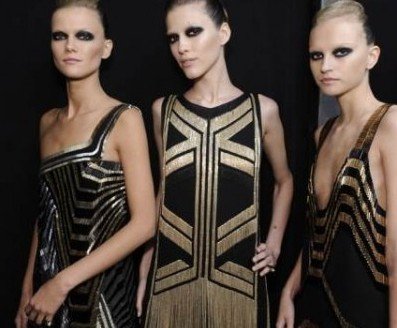Dressing the Part: 2012-2013 Italian collections have a vintage filmic quality
When movies first began to be mass-marketed, right after the turn of the century, actors and actresses usually looked to their own closets for contemporary stories. For period pieces, of course, a wardrobe department was necessary, but it was not until 1916 that the first costume designer was credited on film, a certain Frenchman Louis J. Gasnier. Designed for American serial heroine Pearl White, his creation, a black suit with white blouse accompanied with a black beret, immediately caught on among young women of the day. The era of the Hollywood designer had begun! 50 years later, the costumes designed by great artists and costume designers of the Italian ateliers, like Sartoria Farani (established in 1962) and Sartoria Tirelli (1964), two of the most notable Italian costume houses, have enriched the films that marked the history of our cinema. The value of this work is internationally recognized. These designers have dressed the dreams of great directors giving life to their characters and images. Great costumes define film legends; remember the oversized coat worn by Totò in The Hawks and the Sparrows (Pasolini 1966), Donald Sutherland’s eighteenth-century tails in Fellini’s Casanova (1976) or the blue tailcoat worn by Marcello Mastroianni in Fellini’s Intervista (1987)? Costume designers like Oscar winners Danilo Donati (1976, Fellini’s Casanova), Gabriella Pescucci (1992, for Martin Scorsese’s The Age of Innocence), Milena Canonero (twicewon: 1981, Hugh Hudson’s Chariots of Fire, 2005, Sofia Coppola’s Marie Antoinette), have all left their mark. Not forgetting Piero Tosi, known for his thoroughness and acute aesthetic sense (think about Luchino Visconti’s Rocco and His Brothers, 1960; Ludwig, 1972; The Leopard, 1963). It is said that Terence Stamp praised Tosi’s designs in the surreal ‘Toby Dammit’ sequence in Fellini’s Histoires extraordinaires (1968) as vital in helping him play the part.
The costume designer’s primary relationship, in fact, is with actor, who often feels in character once in costume but also expects the designer to exalt good features. And here’s why costume designers (like those mentioned above) contributed to the creation of unforgettable movie characters that became fashion icons. It was at this point that fashion designers started to translate the style of the most fashionable movie characters of all time into real life: fashion meets cinema and vice versa.
For spring summer 2012, in fact, several Italian designers drew their inspiration from movies, like Federico Fellini’s La Dolce Vita and Michelangelo Antonioni’s L’avventura. Definitely one of the hottest trends for this summer is the strong Fifties appeal, a golden age on which fashion has focused on. Embracing their Italian roots, Dolce & Gabbana, Missoni and Pucci, were all about fiery Latin women, like the tempestuous Sophia Loren in Stanley Kramer’s The Pride and the Passion or the wild and beautiful Julia Migenes in Francesco Rosi’s Carmen; instead Miuccia Prada preferred a collection inspired by Audrey Hepburn in Roman Holiday. Who can forget Brigitte Bardot in Roger Vadim’s And God Created Woman? The ensemble featuring printed top and hot pants by Dolce & Gabbana and the low-necked pleated dress by Prada, recreate B.B.’s look.
The Twenties are a strong presence this season too: Alberta Ferretti’s collection reminds the 1920s ‘flapper girl’ dresses, like the ones worn by Mia Farrow in Jack Clayton’s The Great Gatsby. Also dancing the Charleston are Gucci’s models, stunning like Bérénice Bejo in The Artist, best-picture Oscar at the 84th Academy Awards.
Barbara Zorzoli is a Columnist for the Italian Journal.
